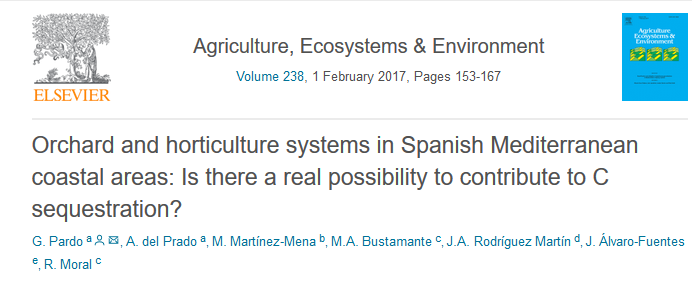BC3 Journal Article “Orchard and horticulture systems in Spanish Mediterranean coastal areas: Is there a real possibility to contribute to C sequestration?”


Go to external source
Pardo, G., del Prado, A., Martínez-Mena, M., Bustamante, M. A., Martín, J. R., Álvaro-Fuentes, J., & Moral, R. 2017. Orchard and horticulture systems in Spanish Mediterranean coastal areas: Is there a real possibility to contribute to C sequestration?. Agriculture, Ecosystems & Environment.238 (1) 153-167. DOI (10.1016/j.agee.2016.09.034).
Abstract
Agriculture in the Mediterranean basin is currently contributing to greenhouse gas emissions (GHG) and in the future is expected to be strongly affected by climate change. Increasing soil organic carbon (SOC) via soil organic matter (SOM) improvement is widely regarded as a way to both mitigate and adapt to climate change. Using as a case study the Mediterranean coastal area in Spain, which is regarded as one of the most intensively managed areas in Europe for orchards and horticultural cropping, we analyzed the potential for climate change mitigation of introducing different practices that are expected to increase SOC. We selected both as a single measure and in combination, cover cropping and application to the soil of the available underutilized exogenous organic matter (EOM), treated (e.g. composted or digested) or non-treated. These practices were compared against a baseline scenario that intended to reflect the current practices in the area (e.g. all livestock manure produced in the area is applied to the agricultural soil). We carried out a modelling exercise at the regional scale using the agricultural activity data and current climatic conditions as inputs. Modelling runs were performed coupling a widely used dynamic model of SOC turnover (RothC) with a model to simulate the GHG emissions from EOM processing or storage prior to soil application (SIMSWASTE).
Results indicate that the most promising practice, considered as a single measure and with respect to the baseline, was introducing cover crops in woody cropping systems. This practice resulted in an increase of 0.44 Mg C ha−1 yr−1 during the first 20 years (range 0.41–0.52 Mg C ha−1 yr−1) and led to a total SOC accumulation of about 30 Tg C after 100 years. Amendment of all agricultural land with available underutilized EOM resulted in an increase of up to 0.09 Mg C ha−1 yr−1 (range 0.07–0.16 Mg C ha−1 yr−1) as a single measure (urban waste) and 0.13 Mg C ha−1 yr−1 (range 0.11–0.21 Mg C ha−1 yr−1) as a combined measure (urban waste and composted agroindustry by-products), leading to a total SOC accumulation of about 7 Tg C (urban waste) and 10 Tg C (urban waste and composted agroindustry by-products) after 100 years. Manure anaerobic digestion or composting as a single measure did not result in significant SOC changes but, if GHG emissions and savings from manure storage and processing management stages are considered, they could help to reduce about 4.3 (anaerobic digestion) or 1.1 Tg CO2eq yr−1 (composting) in the study area, which represents a significant amount compared with total agricultural emissions in Spain.
